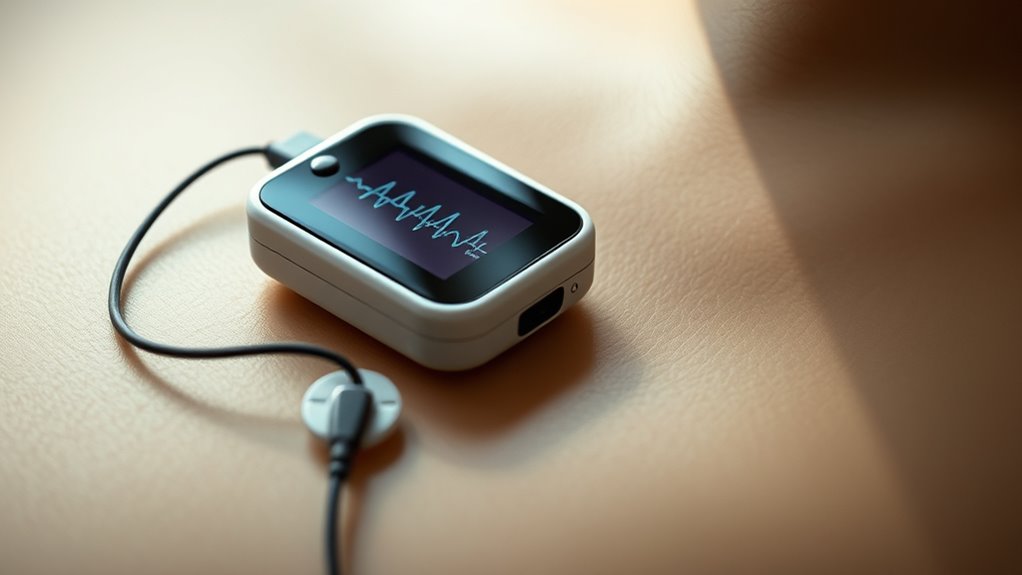A Holter monitor is a portable device that continuously records your heart’s electrical activity for 24 to 48 hours. It uses electrodes placed on your chest to capture real-time ECG data, helping to detect irregular heartbeats that standard ECGs might miss. It’s often recommended if you experience symptoms like palpitations or dizziness. The results provide valuable insights into your heart’s health and treatment effectiveness. If you’re curious about how it works, there’s more to discover.
Understanding the Holter Monitor
A Holter monitor is a portable device that continuously records your heart’s electrical activity over a specified period, typically 24 to 48 hours. Developed in the late 1940s by Dr. Norman Holter, this technology allows healthcare providers to monitor heart rhythms during daily activities, providing essential insights into cardiovascular health. One of the key Holter monitor benefits is its ability to detect irregular heartbeats that may not appear during a standard ECG. By capturing data over an extended period, it helps identify transient conditions and assess treatment efficacy. This non-invasive method empowers you to maintain your freedom while ensuring thorough heart health evaluation, paving the way for personalized care tailored to your unique needs.
How a Holter Monitor Works
Holter monitors function by utilizing electrodes placed on your chest to capture continuous electrocardiogram (ECG) data. This allows for real-time monitoring of your heart’s electrical activity over a specified period, usually 24 to 48 hours. The data collected helps identify irregular heartbeats and other cardiac issues. There are various Holter monitor types, including standard, event, and telemetry monitors, each serving specific purposes based on your needs.
| Holter Monitor Type | Description | Use Case |
|---|---|---|
| Standard | Continuous ECG recording | General heart monitoring |
| Event | Records during symptoms | Intermittent arrhythmias |
| Telemetry | Wireless transmission of data | Remote monitoring |
This functionality guarantees thorough insights into your heart health.
Reasons for a Holter Monitor Test
When experiencing symptoms like palpitations, dizziness, or chest discomfort, your doctor may recommend a Holter monitor test to gain deeper insights into your heart’s activity. This continuous monitoring allows for thorough assessment of your heart rhythm over 24 to 48 hours. It’s particularly useful for arrhythmia detection, as it captures irregularities that may not show up during a standard ECG. If you’ve had unexplained fainting spells or if you’re currently on medication that affects heart function, this test can provide critical data. It can also help evaluate the effectiveness of treatments for known heart conditions. By understanding your heart’s rhythms, you’ll have a clearer picture of your cardiovascular health and the necessary steps to take for ideal well-being.
What to Expect During the Test
Before the test begins, you’ll be fitted with small electrodes that will be placed on your chest. These electrodes will connect to a portable recording device, allowing for continuous monitoring of your heart activity. The test duration typically spans 24 to 48 hours, during which you’ll go about your daily routine. This patient experience is designed to capture your heart rhythm in various situations, providing valuable data for your healthcare provider. You’ll be instructed to maintain a diary of activities and symptoms during this period, which aids in correlating any irregularities with your normal activities. It’s important to keep the device dry and avoid activities that may damage it. Overall, the process is straightforward and minimally intrusive.
Interpreting Holter Monitor Results
Interpreting the results from a Holter monitor involves analyzing the recorded data to identify any irregularities in your heart rhythm. Your healthcare provider will focus on Holter monitor findings, primarily looking for signs of arrhythmia detection.
The data is typically presented in a report that highlights significant events, including:
| Event Type | Description |
|---|---|
| Normal Beats | Regular heart rhythm observed |
| Premature Beats | Extra beats occurring before normal |
| Atrial Fibrillation | Irregular, rapid heartbeats |
| Ventricular Tachycardia | Fast heart rhythm from ventricles |
Understanding these findings can help you and your doctor make informed decisions about your heart health. Regular follow-ups may be necessary based on the results.
Frequently Asked Questions
How Long Can I Wear a Holter Monitor?
Imagine your heart’s journey captured like a fleeting melody. You can wear a Holter monitor for 24 to 48 hours, but wear time limitations vary per individual, ensuring your rhythm’s truth is revealed without restraint.
Can I Shower While Wearing a Holter Monitor?
You can’t shower while wearing a Holter monitor. To guarantee monitor safety, consider using a sponge bath instead. If necessary, ask your healthcare provider for specific showering tips to maintain the device’s integrity.
Are There Any Risks Associated With Wearing a Holter Monitor?
Wearing a Holter monitor can feel like carrying a feathered anchor. You might experience monitor discomfort or skin irritation, but these risks are usually minimal. Embrace the process; it’s a step toward understanding your heart’s rhythm.
How Do I Care for the Holter Monitor During the Test?
To care for the Holter monitor, guarantee proper monitor maintenance by keeping it dry and avoiding moisture. For electrode care, don’t remove them, and gently clean the skin around them if necessary.
Will My Insurance Cover the Cost of a Holter Monitor Test?
Your insurance may cover the cost of a Holter monitor test, but it depends on your specific insurance policies and coverage limits. Check with your provider to understand what’s included and any potential out-of-pocket costs.

